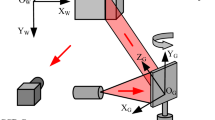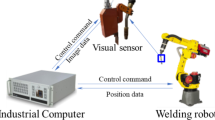Abstract
Laser-processing system plays an important role in modern processing. To improve the precision of a galvanometer laser-processing system, a novel compensation method based on machine vision is proposed. First, the various errors existing in the scanning process of the galvanometer system and the influence on the accuracy of the scanning system were analyzed. Second, processing a specific grid within the processing range of the laser-processing system, the machine vision method was employed to extract the skeleton image and obtain the sub-pixel coordinates of each grid corner point. By comparing them with their theoretical positions, the position and error of all corner points of the mesh were obtained. Finally, the position and error of the four corner points in the arbitrary grid region were analyzed by the weighted interpolation method, and the error value and compensation value of any point in the grid were derived, and an error compensation model was established to compensate the scanning system. To verify the effectiveness of the proposed compensation method, a compensation experiment was conducted, and the workpiece machining accuracy after compensation was improved. The method is simple in operation, offers good compensation effect, and has important theoretical significance and practical value for improving the precision of laser-processing systems.












Similar content being viewed by others
References
Q. Zhao, C. Wang, J. Yang, Graphic distortion analysis and correction arithmetic research on laser galvanometer scanning. J. Changchun Univ. Sci. Technol. 35(4), 63–65 (2012)
A. Manakov, H. Peter, I. Ivo, A mathematical model and calibration procedure for galvanometric laser scanning systems, in 16th international workshop on vision, modeling and visualization (2011)
H. Jigang, Q. Qin, W. Jie, F. Hui, Two dimensional laser galvanometer scanning technology for additive manufacturing. Int. J. Mater. Mech. Manuf. 6(5), 332–336 (2018)
G. Li, Y. Fang, R. Ji, Z. Zhang, H. Zhang, Mu. Jinzhen, T. Song, High-precision laser tracking system based on two-dimensional galvanometers and position sensitive detectors. Chin. J. Lasers 46(7), 0704007 (2019)
S. Huilai, L. Shuzhong, Research on errors reasons in dual-galvanometric laser scanning manufacturing. Laser Infrared 35(3), 161–163 (2005)
Y. Zhao, L. Bingheng, Pillow-shaped distortion correction algorithm of galvanometric scanning system. Chin. J. Lasers 35(3), 161–163 (2005)
A. Lasagni, M.A.O. Delgado, M.A. Ortega, Reducing field of view distortion for galvanometer scanning system using a vision system. Opt. Lasers Eng. 86, 106–114 (2016)
X. Zheng, X. Ni, Z. Lu et al., Detection of nonlinear scanning error for f-theta objective. Opto-Electron. Eng. 31(4), 9–12 (2004)
C. Zhibin, F. Lei, X. Wenjian et al., Directional error analysis of 2D galvanometer scanning system. J. Appl. Opt. 39(2), 180–186 (2018)
A. Jagna, K.A. Kumar, V.K. Prasad, Rule-based order-independent parallel algorithm for binary image thinning. Int. J. Theor. Appl. Mech. 11(2), 171–185 (2016)
M. Shaomin, D. Haiyang, S. Ping et al., A New improved fast parallelthinning algorithm. Microelectron. Comput. 30(1), 53–55 (2013)
W. Wang, Y.P. Tang, J.L. Ren et al., An improved algorithm for Harris corner detection. Opt. Precis. Eng. 16(10), 1995–2001 (2008)
Y.-T. Liang, Y.-C. Chiou, An effective corner detection method using subpixel edge detector and Gaussian filter. Sensor Rev. 30(1), 51–61 (2010)
Ai. Yufeng, Z. Min, Z. Qi et al., Corner detection of checkerboard based on sub-pixel edge. J. Xi’an Univ. Technol. 35(3), 333–337 (2019)
C. Nian, Z. Haiyuan, Z. Nan et al., Using bilinear interpolation and wavelet transformation to zoom images based on an error-amended sharp edge algorithm. Laser Infrared 40(5), 558–562 (2010)
Acknowledgements
The project was supported by National Key Research & Development Programme of China (2017YFB1104600) and the Open Fund of the State Key Laboratory of Integrated Optoelectronics (IOSKL2018KF03).
Author information
Authors and Affiliations
Corresponding author
Ethics declarations
Conflict of interest
The authors declare no conflicts of interest.
Additional information
Communicated by Dieter Meschede.
Publisher's Note
Springer Nature remains neutral with regard to jurisdictional claims in published maps and institutional affiliations.
Rights and permissions
About this article
Cite this article
Chen, G., Zhang, Y. & Tian, P. An error compensation method based on machine vision for laser-processing systems with galvanometers. Appl. Phys. B 127, 3 (2021). https://doi.org/10.1007/s00340-020-07550-0
Received:
Accepted:
Published:
DOI: https://doi.org/10.1007/s00340-020-07550-0




